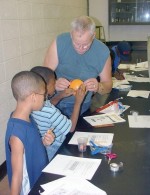
The second Summer Science Camp for Children ended its enrichment program with a bang Friday, June 30. During the one-week program the approximately 28 students participated in class sessions with 10 returning science campers from last year. Each science camper was awarded a certificate of participation and a backpack that holds swim wear and lunch. The camp was directed and coordinated by Dr. Connie Walton-Clement, dean of the College of Arts and Sciences. The Summer Science Camp provided a community of young learners from ages 8 to 10 years old that encouraged deep thinking, exploration, and analysis. “One of the reasons for implementing the summer science camp was to get kids excited about science and mathematics,” said Dr. Walton-Clement. Each activity began with a scenario that caused the students to use their existing knowledge. When they responded to the questions, the activities began. Before each activity, Dr. Walton-Clement demonstrated concepts that she wanted the students to understand. For example, when she talked about mixtures, which was the basis for the chromatography activity, she used peas, marbles, sugar, and flour. When she mixed peas and marbles together, the students could separate them based on their appearance. When she mixed sugar and flour together, they could not separate them because the mixture appeared to be the same. This is when she explained that chromatography was a technique that separated mixtures by using different solvents. The students were amazed at the blue, orange, and pink colors that migrated from a crayon marker, sharpie marker, and permanent marker on filter paper. Solvents used to separate different colors were acetone (nail polish remover), isopropyl alcohol (rubbing alcohol), and water. Dr. Walton-Clement enhanced the math skills of the science campers by having them to construct a scale using a rubber band, ruler, tape, and small cup. This activity was called “Stretching to make a point.” When the students put different amount of pennies in the cup, the rubber band began to stretch. They were able to calculate the length of the stretched rubber band in centimeters. In another activity called “It’s gonna be big,” the kids were able to measure the circumference of a balloon by blowing a certain number of breaths in it. The kids used a piece of yawn to measure the circumference of the balloon in centimeters. Computer technology was a vital component of the science activities. The kids went to the Computer laboratory to use the Microsoft EXCEL program to graph their results. This activity enhanced their computer skills as well as their mathematics skills. Other activities included using red cabbage leaves to make an indicator solution. The kids used solutions of bleach, lemon juice, and pickle juice to see a change in the cabbage indicator. When the cabbage indicator turned pink it was considered to be an acid, and when it turned yellow it was a base. The highlight of the experiments was when the science campers made volcanoes. This activity was so much fun, because they had to use flour and water to make dough to hold the test tube filled with baking soda. The campers had different colors of volcanoes because they chose different food color to put in the vinegar and detergent mixture. There were yellow, green, red, and blue volcanoes erupting everywhere. Just when you thought that nothing can top the volcanoes, Dr. Walton-Clement came up with another exciting experiment. She told the science campers, “today we are going to make slime!” The kids made a slimy, monster-looking material by using glue, water, borax solution, and food color. “It is the science of the activities that made them so great,” explained Dr. Dorsey. On the last day of the camp, Dr. Walton-Clement showed the campers how to do a Powerpoint presentation that highlighted their results.
